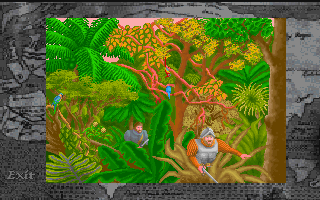Retro Replay Review
Gameplay
Columbus Discovery’s core gameplay revolves around assembling historical images that have been split into 30 fragments and placed on the faces of virtual bricks. The player can freely rotate each cluster of bricks in the vertical plane, flip them over in the horizontal plane, and relocate them on the board to discover hidden pieces. This three-dimensional puzzle mechanics injects depth and variety into each stage, compelling you to visualize how fragments align not only in two dimensions but in 3D space.
(HEY YOU!! We hope you enjoy! We try not to run ads. So basically, this is a very expensive hobby running this site. Please consider joining us for updates, forums, and more. Network w/ us to make some cash or friends while retro gaming, and you can win some free retro games for posting. Okay, carry on 👍)
The challenge lies in minimizing your moves: every rotation, flip, and swap counts toward your final rating. This encourages a thoughtful, methodical approach—rushing through leads to a lower score, while calculated planning yields top marks. As you learn to anticipate where each fragment belongs, the satisfaction of fitting together multiple pieces in a single maneuver becomes a gratifying “aha!” moment that fuels continued play.
Each completed image triggers a lighthearted musical cue and an animated flourish, rewarding your progress and offering a momentary palate cleanser between more demanding puzzles. Over the course of 30 stages, the gameplay loop remains fresh thanks to steadily increasing complexity—more intricate brick configurations, subtler color palettes, and occasional optical illusions that test your attention to detail.
Graphics
Visually, Columbus Discovery leans into a clean, polished aesthetic. The fragmented images are rendered with crisp lines and rich colors that evoke classic map illustrations and period art. Each historical scene—from caravel voyages to indigenous coastal villages—is presented with enough fidelity to be recognizable, yet stylized enough to feel approachable and game-like.
The 3D brick clusters have a subtle physicality to them: slight shading, realistic edge wear, and dynamic lighting that casts believable shadows as you rotate or flip pieces. This tactile quality makes you feel as though you’re handling genuine objects rather than flat sprites. The user interface is minimal, keeping the on-screen clutter to a minimum so that your focus remains on the puzzle itself.
Completion animations are a highlight: once you slot in the final fragment, the game bursts into life with a jaunty, period-inspired tune and a short vignette that celebrates your success. While not overly elaborate, these moments provide just the right amount of fanfare to keep the atmosphere light and rewarding without overstaying their welcome.
Story
Though Columbus Discovery is primarily a puzzle game, it weaves a loose narrative thread through its selection of images, all centered on the conquest and exploration of the Americas. Each assembled picture is a snapshot of a moment in that historical journey—ships setting sail, first landfalls, meetings with indigenous peoples, and the eventual establishment of colonies.
The chronological progression of images gives a sense of unfolding history: you aren’t simply solving isolated puzzles, but rather unlocking chapters in a grander exploration saga. This structure adds an educational overlay, as players can glean insights into maritime routes, period clothing, and the evolving nature of early encounters.
While the game doesn’t feature dialogue or character development in the traditional sense, the act of piecing together these historical vignettes creates an implicit story arc. Completing each puzzle feels like contributing to a digital mosaic of discovery, and by the end of the 30th image, you’ve effectively “traveled” alongside Columbus through a series of interactive illustrations.
Overall Experience
Columbus Discovery strikes a satisfying balance between accessible puzzle mechanics and gradually escalating difficulty. Early levels ease you into the rotation and flipping controls, while later stages demand increasingly sophisticated spatial reasoning and move efficiency. This makes the game suitable for both casual players seeking a relaxing challenge and enthusiasts looking for a mental workout.
The presentation is polished but never flashy, allowing the historical imagery and smart puzzle design to take center stage. Sound cues and animations at puzzle completion add just enough charm to keep the experience lighthearted, without detracting from the game’s cerebral focus.
Ultimately, Columbus Discovery is a delightful puzzle experience with a unique 3D twist and an educational bent. If you enjoy methodical problem-solving, appreciate historical art, and relish the satisfaction of clearing a board with minimal moves, this title is well worth adding to your collection. Whether you have a few minutes or a few hours, the game offers a rewarding journey through the puzzles—and the past.
 Retro Replay Retro Replay gaming reviews, news, emulation, geek stuff and more!
Retro Replay Retro Replay gaming reviews, news, emulation, geek stuff and more!








Reviews
There are no reviews yet.